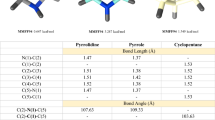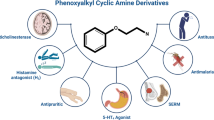Abstract.
Two mechanisms are responsible for the positive inotropic effect of the cardiotonic drug milrinone, i.e., inhibition of type III cAMP phosphodiesterase (PDE III), and displacement of endogenous adenosine from A1 inhibitory receptor. Since PDE III inhibition may increase the likelihood of cardiac arrhythmias by increasing cAMP content, our attention focused on the synthesis of new compounds with more pronounced characteristics as adenosine antagonists.
In this work, four new milrinone analogues were studied, in comparison with the parent drug, for their effects on the contractility of guinea pig isolated atrial preparations, their ability to antagonize endogenous adenosine at the level of A1 receptor, and to inhibit the activity of PDE III partially purified from guinea pig heart. The new compounds present various chemical substitutions with respect to the parent drug: in compounds SF397 (methyl 5-cyano-2-methyl-6-oxo-1,6-dihydropyridine-3-carboxylate) and SF399 (benzyl 5-cyano-2-methyl-6-oxo-1,6-dihydropyridine-3-carboxylate), the 4-pyridil moiety of milrinone was replaced with a methoxycarbonyl and a benzyloxycarbonyl group, respectively; the same structural modifications were also associated with the replacement of the cyano-group in 5-position with an acetyl group in compounds SF416 (methyl 5-acetyl-2-methyl-6-oxo-1,6-dihydropyridine-3-carboxylate) and SF419 (benzyl 5-acetyl-2-methyl-6-oxo-1,6-dihydropyridine-3-carboxylate).
All the new compounds had a marked positive inotropic effect, most of them also being more active and more potent than milrinone. When their affinity for A1 receptor was assessed as the displacement of [3H] 8-cyclopentyl-1,3-dipropylxanthine ([3H]DPCPX) from cardiac membranes, SF397 and SF399 showed affinity (Ki of about 600 nM) similar to that of milrinone (Ki 550 nM). By contrast, SF416 and SF419 had very low (Ki of about 10,000 nM) or scarce (Ki of about 2,000 nM) anti-adenosine component, respectively. All the new compounds inhibited PDE III activity, their Ki values proceeding in the following order: milrinone (3.80 μM) <SF397 (7.00 μM) <SF399 (8.80 μM) <SF416 (35.00 μM) SF419< (155.00 μM). To better characterize the mechanisms responsible for the positive inotropic response of the new compounds, we also investigated the effects of new analogues on some systems (ATP-dependent Ca2+ uptake, Ca2+ATPase, Na+/K+ATPase, Na+/Ca2+ exchange carrier) or a receptor (β-adrenoceptor) mainly involved in the control of cardiac contractility. None of the tested compounds inhibited enzyme or transport systems; however, SF397, SF399 and SF416, although to different extents, had a direct β-adrenergic action. Indications about structure-activity relationships are tentatively discussed, in order to obtain useful information for the design of new analogues with better pharmacological profiles.



Similar content being viewed by others
References
Alousi AA, Farah AE (1980) Letter to the editor. Circ Res 46:887–888
Alousi AA, Farah AE, Lesher GY, Opalka CJ Jr (1979) Cardiotonic activity of amrinone-WIN 40680 (5'-amino-3,4'-bipyridin 6(1H)-one. Circ Res 45:666–677
Belardinelli L, Isenberg G (1983) Isolated atrial myocytes: adenosine and acetylcholine increase potassium conductance. Am J Physiol 244:H734−H737
Carpenedo F, Floreani M, Cargnelli G (1984) Competitive inhibition of phosphodiesterase activity by amrinone: its implication in the cardiac effect of the drug. Pharmacol Res Commun 16:969–977
Cheng JC, Prusoff WH (1973) Relationship between the inhibition constant (Ki) and the concentration of inhibitor that causes 50 percent inhibition (I50) of an enzymatic reaction. Biochem Pharmacol 22:3099–3108
Dixon M (1953) The determination of enzyme inhibitor constants. Biochem J 55:170–171
Dorigo P, Maragno I (1986) Interaction of amrinone with endogenous adenosine in guinea pig atria. Br J Pharmacol 87:623–629
Dorigo P, Gaion RM, Maragno I (1990) Involvement of purine compounds in the inotropic action of milrinone. Cardiovasc Drugs Ther 4:509–514
Dorigo P, Gaion RM, Belluco P, Mosti L, Borea PA, Maragno I (1991) An analysis of the mechanisms of the inotropic action of some milrinone analogues in guinea pig isolated atria. Br J Pharmacol 104:867–872
Dorigo P, Gaion RM, Belluco P, Borea PA, Guerra L, Mosti L, Floreani M, Carpenedo F (1992) Antagonism toward endogenous adenosine and inhibition of cGI-PDE in the cardiac effects of amrinone, milrinone and related analogues. Gen Pharmacol 23:535–541
Dorigo P, Gaion RM, Belluco P, Fraccarollo D, Maragno I, Bombieri G, Benetollo F, Mosti L, Orsini F (1993) A pharmacological, crystallographic, and quantum chemical study of new inotropic agents. J Med Chem 36:2475–2484
Dorigo P, Fraccarollo D, Santostasi G, Maragno I, Floreani M, Borea PA, Mosti L, Sansebastiano L, Fossa P, Orsini F, Benetollo F, Bombieri G (1996) Synthesis and cardiotonic activity of novel pyrimidine derivatives. Crystallographic and quantum chemical studies. J Med Chem 39:3671–3683
Dorigo P, Fraccarollo D, Gaion RM, Santostasi G, Borea PA, Floreani M, Mosti L, Maragno I (1997) New inotropic agents: milrinone analogues. Gen Pharmacol 28:781–788
Earl CQ, Linden J, Weglicki WB (1986) Biochemical mechanisms for the inotropic effect of the cardiotonic drug milrinone. J Cardiovasc Pharmacol 8:864–872
Endoh M (1979) Correlation of cyclic AMP and cyclic GMP levels with changes in contractile force of dog ventricular myocardium during cholinergic antagonism of positive actions of histamine, glucagon, theophylline and papaverine. Jpn J Pharmacol 29:855–864
Endoh M (2002) Mechanisms of action of novel cardiotonic agents. J Cardiovasc Pharmacol 40:323–338
Endoh M, Yamashita S, Taira N (1982) Positive inotropic effect of amrinone in relation to cyclic nucleotide metabolism in the canine ventricular muscle. J Pharmacol Exp Ther 221:775–783
Endoh M, Yamashita S, Taira N, Blinks J (1986) Effects of new inotropic agents on cyclic nucleotide metabolism and calcium transient in canine muscle. Circulation 73 [Suppl 3]:117–133
Farah AE, Alousi AA (1978) New cardiotonic agents: a search for digitalis substitute. Life Sci 22:1139–1148
Floreani M, Forlin A, Pandolfo L, Petrone M, Bellin S (1996) Mechanisms of plumbagin action on guinea pig isolated atria. J Pharmacol Exp Ther 278:763–770
Floreani M, Borea PA, Gessi S, Mosti L, Fossa P, Dorigo P (1997) A new milrinone analog: role of binding to A1 adenosine receptor in its positive inotropic effect on isolated guinea pig and rat atria. J Pharmacol Exp Ther 283:541–547
Fossa P, Boggia R, Lo Presti E, Mosti L, Dorigo P, Floreani M (1997) Inotropic agents: synthesis and structure-activity relationships of new milrinone related cAMP PDE III inhibitors. Farmaco 52:523–530
Fossa P, Boggia R, Mosti L (1998) Toward the identification of the cardiac cGMP inhibited-phosphodiesterase catalytic site. J Comput Aided Mol Des 12:361–372
Honerjäger P, Schäfer-Korting M, Reiter M (1981) Involvement of cyclic AMP in the direct inotropic action of amrinone: biochemical and functional evidence. Naunyn-Schmiedebergs Arch Pharmacol 318:112–120
Ito M, Tanaka T, Saitoh M, Masuoka H, Nakano T, Hidaka H (1988) Selective inhibition of cyclic AMP phosphodiesterases from various human tissues by milrinone, a potent cardiac bipyridine. Biochem Pharmacol 37:2041–2044
Jones RL, Besch HR Jr, Watanabe AM (1977) Monovalent cation stimulation of Ca2+ uptake by cardiac membrane vesicles. J Biol Chem 252:3315–3323
Kobylarz DC, Steffen RP, Weishaar RE, Evans DB (1985) Relationship between inhibition of ventricular peak III phosphodiesterase and the in vivo cardiotonic effect of CI−914 in several species. Pharmacologist 27:603–609
Lathers CM, Roberts J (1980) Digitalis cardiotoxicity revisited. Life Sci 27:1713–1733
Lowry OH, Rosebrough NJ, Farr, AL, Randall RJ (1951) Protein measurement with the Folin phenol reagent. J Biol Chem 193:265–275
Lubbe WF, Podzuwett T, Opie LH (1992) Potential arrhythmogenic role of cyclic monophosphate (AMP) and cytosolic calcium overload: implications for prophylactic effects of beta-blockers in myocardial infarction and proarrhythmic effects of phosphodiesterase inhibitors. J Am Cell Cardiol 19:1622–1655
Mason DT, Zelis R, Lee G, Hughes JL, Spann JF, Amsterdam EA (1971) Current concepts and treatment of digitalis toxicity. Am J Cardiol 27:546–559
Massie BM (1998) 15 years of heart-failure trials what have we learned. Lancet 352:St29−St33
Menozzi G, Mosti L, Schenone P (1987) Reaction of 2-dimethylaminomethylene-1,3-diones with nucleophiles. VI. Synthesis of ethyl or methyl-disubstituted 1-H-pyrazole-4-carboxylates. J Heterocycl Chem 24:1669–1675
Miller RR, Palomo AR, Brandon BS, Hartley CJ, Quinones MA (1981) Combined vasodilator and iotropic therapy of heart failure: experimental and clinical concepts. Am Heart J 102:500–508
Moos WH, Humblet CC, Sircar I, Rithner C, Weishaar RE, Bristol JA, McPhail AT (1987) Cardiotonic agents. (Selective inhibitors of adenosine 3',5'-cyclic phosphate phosphodiesterase III. Elaboration of a five-point model for positive inotropic activity. J Med Chem 30:1963–1972
Munson PJ, Rodbard D (1980) Ligand: a versatile computerized approach for the characterization of ligand binding systems. Anal Biochem 107:220–239
Nicholson CD, Challis RAJ, Shahid M (1991) Differential modulation of tissue function and therapeutic potential of selective inhibitors of cyclic nucleotide phosphodiesterase isoenzymes. Trends Pharmacol Sci 12:19–27
Reiter M (1972) Drugs and heart muscle. Ann Rev Pharmacol 12:111–124
Skomedal T, Schlander I, Aass H, Osnes JB (1988) Properties of the inotropic response in rat papillary muscle to the dihydropyridine Ca-channel activator BAYK8644. Pharmacol Toxicol 63:20–25
Silver PJ, Harris AL, Fort DJ, Perrone MH, Evans DB (1987) Effects of the cardiotonic/vasodilator agents amrinone and milrinone on phosphodiesterase (PDE) isoenzymes and contractile force in guinea pig cardiac and vascular tissue. Fedn Proc 46:373
Slaughter RS, Sutko JL, Reeves JP (1983) Equilibrium calcium-calcium exchange in cardiac sarcolemmal vesicles. J Biol Chem 258:3183–3190
Taylor SH, Silke B, Nelson GJC (1982) Principles of treatment of left ventricular failure. Eur Heart J 3:19–43
Thompson WJ, Brooker G, Appleman MM (1974) Assay of cyclic nucleotide phosphodiesterase with radioactive substrates. Meth Enzymol 38:205–214
Tsien RW (1977) Cyclic AMP and contractile activity in heart. Adv Cyclic Nucl Res 8:363–420
Ward A, Brodgen RN, Heel RC, Speight TM, Avery GS (1983) Amrinone: a preliminary review of its pharmacological properties and therapeutic use. Drugs 26:468–502
Weishaar RE, Burrows SD, Kobylarz DC, Quade MM, Evans DB (1986) Multiple molecular forms of cyclic nucleotide phosphodiesterase in cardiac and smooth muscle and in platelets. Biochem Pharmacol 35:787–800
Weishaar RE, Kobylarz-Singer DL, Steffen RP, Kaplan AR (1987) Subclasses of cyclic AMP specific phosphodiesterase in left ventricular muscle and their involvement in regulating myocardial contractility. Circ Res 61:539–547
Acknowledgements.
This work was supported by grants from MIUR (Ministero dell'Istruzione, dell'Università e della Ricerca, Italy). The experiments reported here were conducted in accordance with the Italian law on experimental use of animals. The experiments were supervised by a veterinary committee to ensure animal care and comfort.
Author information
Authors and Affiliations
Corresponding author
Rights and permissions
About this article
Cite this article
Floreani, M., Fossa, P., Gessi, S. et al. New milrinone analogues: in vitro study of structure-activity relationships for positive inotropic effect, antagonism towards endogenous adenosine, and inhibition of cardiac type III phosphodiesterase. Naunyn-Schmiedeberg's Arch Pharmacol 367, 109–118 (2003). https://doi.org/10.1007/s00210-002-0675-2
Received:
Accepted:
Published:
Issue Date:
DOI: https://doi.org/10.1007/s00210-002-0675-2




